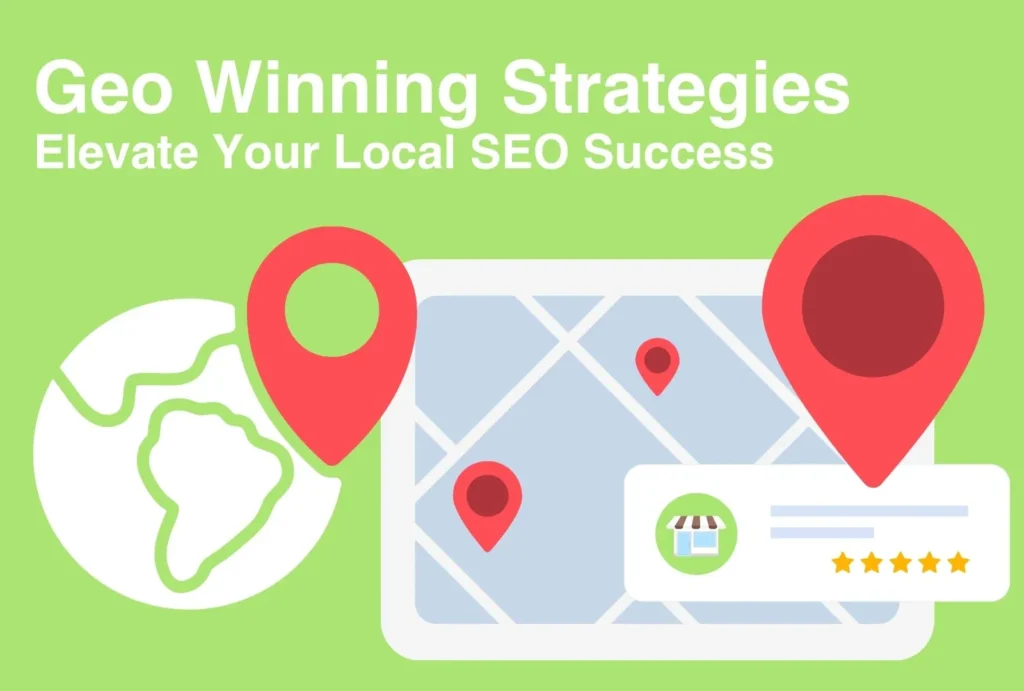In the rapidly changing landscape of digital marketing, maintaining visibility is more competitive than ever. One of the most crucial areas to focus on today is Generative Engine Optimization (GEO). As search engines evolve with artificial intelligence and machine learning, so do the strategies needed to stay at the top of the results. GEO winning strategies empower businesses to dominate local search markets and capitalize on zero-click traffic.
GEO is more than just the latest SEO trend—it’s a fundamental shift in the way content is created, delivered, and experienced. Businesses are no longer competing just for clicks—they’re competing for visibility, authority, and relevance in an AI-driven environment. This article explores how to leverage GEO for long-term success, focusing on practical implementation while maintaining the use of essential SEO principles.
What Is Generative Engine Optimization (GEO)?
Generative Engine Optimization (GEO) represents the evolution of SEO into a more intelligent, adaptive, and user-intent focused discipline. It uses artificial intelligence technologies such as machine learning and natural language processing to produce content that aligns seamlessly with how modern search engines operate.
But what makes GEO unique is its emphasis on hyper-relevant, location-specific content. GEO strategies prioritize understanding the user’s context—like geographic location and search intent—and use advanced algorithms to ensure content is tailored accordingly. This not only improves visibility in local search results but also enhances engagement.
GEO stands apart by emphasizing three main pillars:
- AI search optimization to refine algorithm alignment.
- Structured data for SEO to enhance content comprehension by search engines.
- Natural language SEO to better match the way users naturally ask questions.
Together, these components help GEO go beyond traditional SEO techniques, laying the foundation for competitive and sustainable digital visibility.
Why GEO Matters in the Era of Google SGE and Zero-Click Traffic
Why is GEO becoming indispensable in 2025 and beyond? The answer lies in the shift in user behavior and search engine functionality. Google’s Search Generative Experience (SGE) and the rise of zero-click traffic are fundamentally changing how people consume information.
When visitors get answers on the search results page, they don’t need to go through to a website, which is known as zero-click traffic. While this may seem like a threat to traditional traffic models, GEO turns this into a strategic advantage. By optimizing content for direct answers using structured content and featured snippet optimization, businesses can still capture user attention even without clicks.
GEO helps businesses:
- Gain higher visibility in location-based queries.
- Secure featured snippets to benefit from zero-click results.
- Enhance content relevance using AI-driven insights.
With the increasing dominance of AI search optimization and SGE features, GEO prepares businesses to adapt, survive, and thrive in an evolving search environment.
GEO vs. Traditional SEO: Understanding the Core Differences
While both GEO and traditional SEO share the goal of boosting search rankings and visibility, their approaches differ dramatically. Traditional SEO relies on universal strategies—broad keyword usage, backlink generation, and global relevance. GEO, in contrast, focuses on hyper-localization, user context, and AI-enhanced personalization.
Where traditional SEO may optimize content for global relevance, GEO targets specific user demographics and geographic nuances. It adjusts content not only to keywords but also to user behavior, preferences, and local search patterns.
To summarize:
- Traditional SEO focuses on broad visibility by leveraging backlinks and targeting generic keywords
- GEO emphasizes personalization, structured data, and location-relevant content.
By combining both strategies, businesses can expand their reach while deepening engagement with their target audience, leveraging the best of both worlds.
GEO Optimization Tactics for 2024 and Beyond
As AI continues to dominate the SEO landscape, mastering advanced GEO strategies becomes essential. Here’s how to integrate the most effective GEO tactics to stay ahead of the competition.
How to Optimize for Featured Snippets in Search Results
Featured snippets—often known as “position zero”—are key to winning zero-click traffic. They provide direct answers to user queries, often pulled from content that is structured and precise. To win featured snippet placement, content must directly answer user-intent questions, be well-structured, and use schema markup.
Ensure your content:
- Answers common search queries clearly.
- Uses structured formatting such as paragraphs, tables, or lists.
- Incorporates relevant schema markup to enhance interpretation by Google.
A strong featured snippet optimization strategy builds brand authority, increases visibility, and keeps your content top-of-mind—even when users don’t click through.
Leveraging AI Search Optimization with LLMs and Google SGE
AI search optimization is the foundation of contemporary GEO. Large Language Models (LLMs) such as ChatGPT and tools like Google’s SGE enable a deeper understanding of user intent. By integrating these technologies, businesses can create highly targeted, personalized content.
Using LLMs helps automate and refine content development. Meanwhile, Search Generative Experience (SGE) tools improve how results are presented to users by summarizing and rephrasing web content in an AI-friendly way.
Incorporate AI by:
- Using LLMs to generate optimized content drafts.
- Applying intent-driven language to match conversational queries.
- Enhancing personalization based on search data insights.
This future-focused strategy ensures you remain relevant as Google further integrates generative AI into its search ecosystem.
Using Structured Data for SEO: Why It Matters
Structured data helps search engines parse and understand your content effectively. By adding schema markup to your website, you provide search engines with the necessary context to generate rich results like FAQs, product features, and review ratings.
Implementing structured data improves:
- Search rankings through better comprehension.
- User engagement via enhanced listings.
- Click-through rates by displaying key info upfront.
Structured data is crucial for current SEO in order to stand out in a world that is becoming more automated and data-driven.
Natural Language SEO: Matching How People Actually Search
As voice and conversational search queries grow, natural language SEO becomes a pivotal part of GEO. Rather than focusing on robotic or keyword-stuffed content, GEO strategies prioritize the way real people speak.
Effective natural language SEO includes:
- Writing conversationally and clearly.
- Targeting long-tail queries.
- Structuring content to match spoken questions.
Optimizing for natural language improves voice search results and aligns your content with the AI algorithms that now dominate Google’s ecosystem.
Structuring Content Using Topic Clusters
Topic clusters organize your content in a way that both users and search engines can navigate easily. Instead of isolated articles, you create a central pillar page linked to several sub-topics, forming a logical content network.
This structured content approach helps:
- Increase topical authority.
- Improve internal linking and site structure.
- Encourage deeper user engagement.
Topic clusters are ideal for generative SEO since they offer comprehensive coverage on a subject—perfect for AI summarization and ranking.
Authority Building through Digital PR and Brand Mentions
Establishing authority is vital in GEO. Search engines prioritize websites with a strong reputation, which is built through brand mentions, quality backlinks, and digital PR.
Engage in:
- Press campaigns that build online visibility.
- Collaborations that generate citations and references.
- Relationship building with high-authority sites.
Authority signals are increasingly weighed by search engines as they assess trustworthiness and relevance.
The ChatGPT SEO Strategy: Content Creation with LLMs
LLMs like ChatGPT revolutionize how content is created for GEO. These tools can produce SEO-optimized, natural-sounding content that aligns with user needs and AI requirements. More importantly, they accelerate content production without sacrificing quality.
Use LLMs to:
- Brainstorm topic ideas based on keyword research.
- Draft content that mirrors conversational search.
- Continuously refine and update older content.
When integrated strategically, ChatGPT and similar tools become central to a GEO content workflow.
Technical SEO Best Practices for GEO
In GEO, the technical backbone of your website is just as crucial as the content itself. Factors like site speed, accessibility, and mobile responsiveness significantly influence how search engines evaluate your site’s overall value.
Focus on:
- Fast loading times through optimized caching and CDNs.
- Mobile-first design to serve users on all devices.
- Clear site architecture with intuitive navigation.
These foundational aspects ensure your content is not only discoverable but also usable and appealing to both users and search engines.
How to Measure GEO Performance and Adjust Accordingly
To truly win in GEO, you must consistently monitor your performance. Use analytics tools like Google Search Console, Google Analytics, and rank trackers to evaluate your visibility, traffic sources, and user engagement.
Track:
- Keyword rankings for both general and local terms.
- Click-through and bounce rates.
- Engagement with featured snippets and rich results.
Regular audits and adaptations based on these metrics ensure long-term success and resilience in the evolving SEO landscape.
GEO Mistakes to Avoid When Targeting Local or AI Search
Even the most well-intentioned GEO strategies can falter if common mistakes are made. Among the most frequent are ignoring mobile optimization, failing to implement structured data, and neglecting local keyword relevance.
Avoid:
- Using generic global keywords in place of location-specific ones.
- Forgetting to verify and optimize your Google Business Profile.
- Building content without structured formatting.
Proactively avoiding these errors will put you on the path to sustainable local and zero-click visibility.
The Future of GEO: Trends That Will Define Generative SEO
Looking ahead, several trends will continue to shape how GEO functions. This includes the growing influence of Search Generative Experience (SGE), increased personalization in search results, and the ongoing rise of voice and conversational search.
What to expect:
- Wider integration of generative AI in search rankings.
- Content scoring based on engagement and authority.
- An increasing reliance on AI for both content creation and curation.
To stay ahead, businesses must remain agile—ready to adopt tools and methods that keep them aligned with user needs and search engine preferences.
Conclusion: Building a Sustainable GEO Strategy
Success in GEO isn’t about one-off tactics—it’s about building a long-term strategy grounded in adaptability, AI integration, and user-centered content. From structured data and natural language SEO to ChatGPT-driven content creation, the pillars of GEO are both accessible and essential.
Businesses that embrace GEO and optimize for zero-click traffic will be well-positioned to thrive in the AI-powered search environment of 2025 and beyond. Stay proactive, analyze performance, and always optimize for both search engines and the people using them.
FAQ’s
What is Generative Engine Optimization (GEO)?
GEO is an advanced SEO method that uses AI and machine learning to tailor content for search engines, improving visibility in both local and zero-click searches.
How does GEO help with zero-click traffic?
By optimizing content to appear in featured snippets and AI-generated answers, GEO ensures your content reaches users without requiring a click-through.
What is the difference between traditional SEO and GEO?
Traditional SEO focuses on broad keywords and backlinks. GEO emphasizes local context, structured data, and natural language to match how users actually search.
Is structured data necessary for GEO?
Yes. Structured data helps search engines understand your content and increases the chance of achieving rich results or featured snippets.






